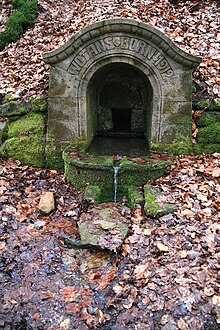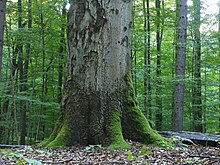Wotansborn
The Wotansborn is a spring taken in 1912 on the Erlesbach in the Steigerwald . An approximately 200-year-old, only two-hectare old beech island is named after him.
Since this beech stock is no longer used, numerous biotope trees were able to develop to different degrees of maturity, so that the visitor has the impression of a natural forest.
location
The Wotansborn is located in the Lower Franconian district of Haßberge in an extensive forest area in Rauhenebrach .
history
This beech stock was owned by the Würzburger Hochstift from 1023 along with the rest of the Steigerwald. Since the forest areas had been cultivated aimlessly well into the 16th century, the Hochstift issued a forest code in 1721 that stipulated that main trees should be left within the playing area. This created multi-layered middle forests, which were used for glass and iron smelting. In 1814 the forest came into the possession of the Kingdom of Bavaria. Since then, the middle forest has developed into a high forest . The stock of oaks used as construction timber declined, while the less sought-after beeches survived.
The approximately 170-year-old beech stand is no longer used for forestry and therefore has a correspondingly large number of biotope trees . Today it encompasses an almost two hectare old wood island with a spring catchment.
Nearby are the Weilersbachtal nature reserve and the Kleinengelein forest department, an approx. Two square kilometer former forest training forest that is no longer used for forestry purposes. As part of the discussion about the designation of a national park in the northern Steigerwald, Kleinengelein was placed under protection as a natural forest reserve with an area of 57.3 hectares in 2010 . The old beech stock has been characterized by ecologically valuable deadwood structures since it was abandoned.
fauna and Flora
The following amphibian species occur at Wotansborn:
- Fire salamander (larvae in the Erlesbach)
- Pond newt
- Mountain newt
- Tree frog
- Agile frog
- Common frog
- Common toad
Picture gallery
| image | Explanation |
|---|---|

|
Fallen beech in "Transwotanien", a narrow strip of forest on the other side of the Erlesbach |

|
Moss skin beech: The trunks of old beeches are often covered with moss on the humid side. |

|
The collar beech has a stem bulge. These are changes caused by beech cancer that are triggered by a parasitic pustular fungus (Nectria ditissima) . The tree does not die from this growth, but it does lose its economic value. |

|
The cave beech is a so-called biotope tree due to its trunk cavity many meters long. Such caves are popular habitats for bats, owls and wild bees. |

|
Great balsam or touch-me-not-an (Impatiens noli-tangere) , known for its centrifugal fruits |

|
Several coral mushrooms (Ramaria spec.) Occur at Wotansborn . They belong to the family of the pig's ear relatives (Gomphaceae). |

|
Red-rimmed tree sponge (Fomitopsis pinicola) , a common tree fungus. It excretes excess water in the form of drops (guttation). |

|
Tinder sponges always align themselves so that the pore layer (bottom side of the hat) is oriented perpendicular to gravity. |

|
The butterfly tramete (Trametes versicolor) is a wood-dwelling species of fungus. |

|
Giant Porling (Meripilus giganteus) - The spore bodies can be up to 1 meter in diameter. |

|
The fire salamander (Salamandra salamandra) is native to Germany mainly in wooded landscapes. |

|
Fire salamander larvae with gills: The Erlesbach offers the essential prerequisites as a habitat for fire salamander larvae: The water is cool and rich in oxygen, poor in nutrients and free of fish. So that the larvae are not washed away, fast-flowing spring streams must also contain zones of standing water. |

|
Cones of a Douglas fir : The scales protruding from the cones were interpreted by the Indians as the rear ends of mice (tail, hind legs), which were, so to speak, pinched when they tried to steal the seeds. |

|
Male tree frog with sound bladder: The tree frog is rare in Lower Franconia, but has a pronounced distribution center in the Steigerwald and in the Haßberge. |

|
Dirt cupling ( Bulgaria inquinans ): When ripe, the mushroom pollutes its surroundings with black spores. These were also used for dyeing in the past. |
Individual evidence
- ↑ http://www.pro-nationalpark-steigerwald.de/
- ↑ http://www.naturwaelder.de/index.php?tpl=detail&id_nwr=2459


